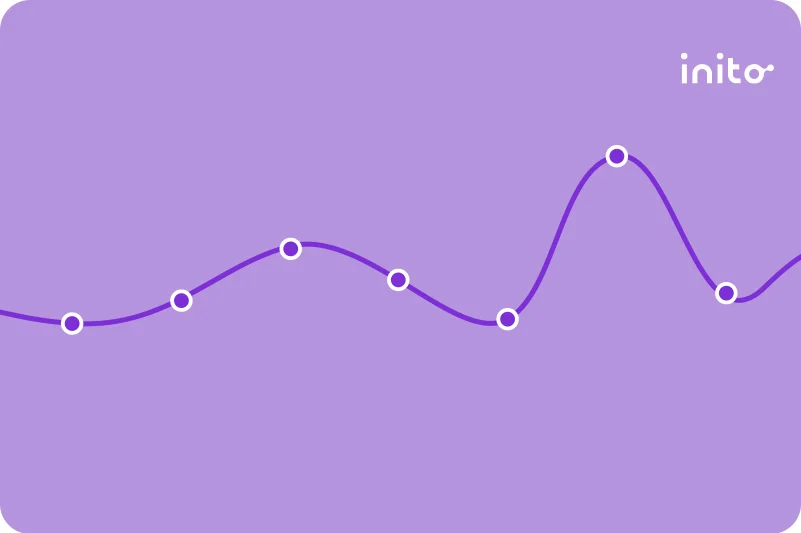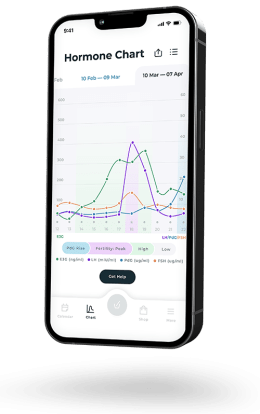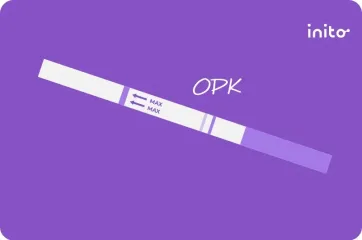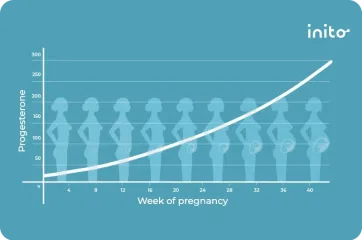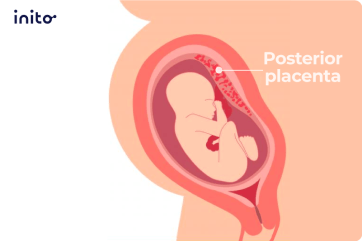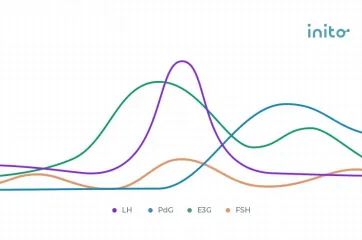Content table
If you’re tracking your ovulation, one question will pop up – “So, what is a normal LH (Luteinizing Hormone) level anyway?”
Unfortunately, there’s no easy answer for this one.
LH surges during your cycle, acting as the spark that sets ovulation into motion. However, LH levels vary widely among individuals and throughout the menstrual cycle.
This makes it challenging to tell what’s ‘normal’ and what’s not.
Read on to clear up the confusion about what normal LH levels and surges typically look like.
Key Takeaways
- Luteinizing hormone (LH) is a fertility hormone that triggers ovulation.
- Your LH level varies throughout your cycle and surges right before ovulation.
- LH surge patterns may have one spike, two or more, or even plateau for several days.
- Surges can have a rapid onset within a day or happen gradually over 2-6 days.
- The initial surge is what predicts ovulation.
- Using a fertility monitor can help you track your LH surge, so you know when to expect ovulation.
- The Inito monitor measures your FSH, LH, estrogen, and PdG, so you know when you’re most fertile.
What Is LH & What Does It Do?
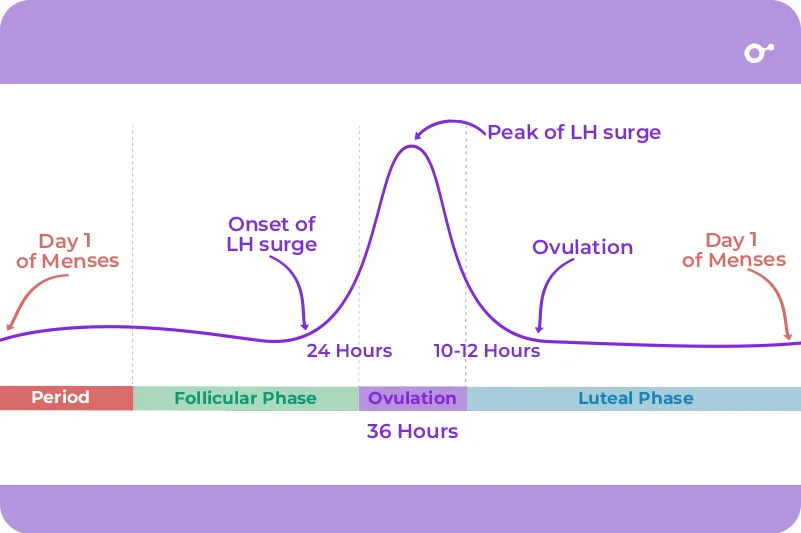
Luteinizing Hormone (LH) is a fertility hormone that your pituitary gland produces. It plays a vital role in your menstrual cycle and is responsible for triggering ovulation.
During most of your cycle, LH levels remain low and stable.
But LH levels shoot up around 24-36 hours before ovulation. This is known as an LH surge, which happens during the follicular phase of your menstrual cycle.
The follicular phase starts on the first day of your period and ends when you ovulate. During this phase, a batch of ovarian follicles, which carry immature eggs, begin developing.
Eventually, the healthiest follicle (aka the ‘dominant follicle’) matures and prepares for release. The LH surge spurs the follicle to free the egg, causing ovulation.
The egg then travels down the fallopian tube, hoping to meet up with sperm. If a sperm is nearby within 24 hours of ovulation, fertilization occurs.
But if fertilization doesn’t happen, you can expect a visit from Aunt Flo.
What's Considered a 'Normal' LH Level?
LH levels vary from person to person and fluctuate throughout your menstrual cycle.
According to the Mayo Clinic, here are the normal LH ranges for women:
LH levels during the follicular phase
As mentioned, your LH is low at the beginning of your cycle until the preovulatory surge. The normal range during your follicular phase would be between 1.9-14.6 mIU/mL.
LH levels during the surge
And now for the burning question on everyone’s minds, “What LH level indicates ovulation?”
According to the Mayo Clinic, LH levels between 12.2-118.0 mIU/mL fall in the normal mid-cycle range.
However, other research suggests there’s even more room for flexibility. One study measured participants’ LH levels daily for an entire menstrual cycle, and ultrasounds were also used to confirm ovulation.
They found that the average LH level during a surge is 44.6 mIU/mL. However, LH levels can range from as low as 6.5 to as high as 101 and still trigger ovulation.
Read more: If You Have No LH Surge, Can You Still Ovulate?
LH levels during the luteal phase
Your luteal phase is the time between ovulation and your next period. After ovulation, your LH levels fall back toward their baseline. LH levels between 0.7-12.9 mIU/mL are considered normal during your luteal phase.
LH levels during pregnancy
If fertilization occurs, your LH levels remain low throughout your pregnancy. Most pregnant women will have LH levels below 1.5 mIU/mL.
LH levels after menopause
Menopause sends estrogen into a nosedive, causing LH levels to rise and remain high. After menopause, LH levels between 5.3 and 65.4 mIU/mL are considered normal.
LH levels chart
Check out the chart below for a snapshot of what ‘normal’ LH levels look like for women:
Time frame | LH level |
Follicular phase | 1.9 – 14.6 mIU/mL |
LH surge | 6.5 – 118.0 mIU/mL |
Luteal phase | 0.7 – 12.9 mIU/mL |
Pregnancy | < 1.5 mIU/mL |
Menopause | 5.3 – 65.4 mIU/mL |
As you can see, if you don’t track your LH regularly, there’s a lot of room for confusion. Say you test one day, and your LH is 12.5 mIU/mL. That value could fall in several different ranges!
Using a fertility monitor like Inito helps you keep track of your LH, providing insight into your unique hormone levels.
Inito also provides a chart to track your hormone levels. You can track your fertile window with estrogen, LH, and FSH and confirm ovulation by tracking your PdG (urine metabolite of progesterone) levels.

See how your hormone chart might look like!
Answer some questions to help us provide you a free personalized hormone chart customized to your hormonal health and conditions
Does Ovulation Always Happen After an LH Surge?
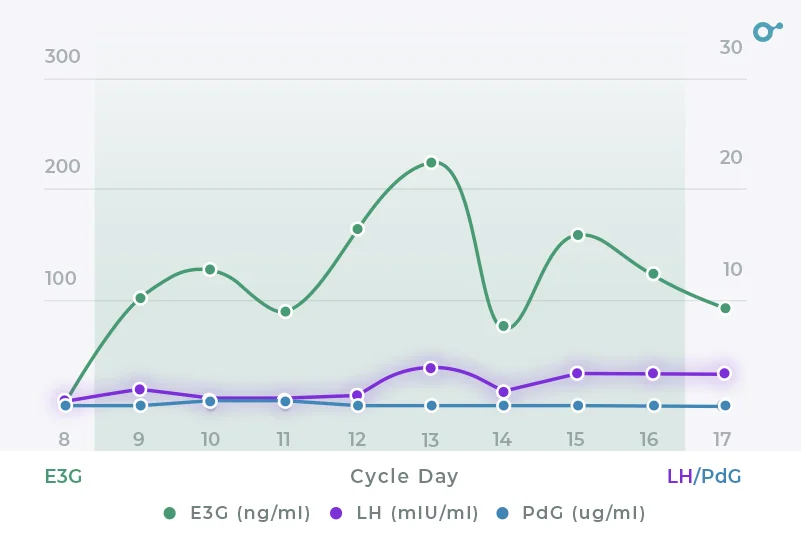
Not always.
An LH surge predicts ovulation, but it doesn’t confirm it. And around one-third of all menstrual cycles are anovulatory – meaning ovulation doesn’t even occur.
This may occur due to health conditions such as Polycystic Ovary Syndrome (PCOS) or Luteinized Unruptured Follicle Syndrome (LUFS), where the dominant follicle fails to rupture.
You might also experience a false LH surge, meaning a rise in LH but no ovulation. This generally happens when your ovulation test gives a false positive due to:
- LH levels are higher than the strip’s threshold
- Multiple LH surges in the cycle
- Cross-reactivity of hormones
Luckily, there is a hormone that confirms ovulation – progesterone.
After an egg is released, the empty follicle forms the corpus luteum. This temporary mass of cells produces high levels of progesterone to support early pregnancy.
A high LH can offer hints about ovulation, but progesterone is what tells you it really happened.
What Are the Different Types of LH Surge Patterns?
It has long been believed that all LH surges occur as a single dramatic peak over 24 hours.
But that couldn’t be farther from the truth.
Some women have one spike, others have two, and some exhibit plateau patterns in which LH remains high for several days.
Here’s what one study had to say about the prevalence of each type of pattern:
Single surge pattern
This is the classic pattern that’s most often shown on LH charts. Around 48% of cycles follow a single surge pattern.
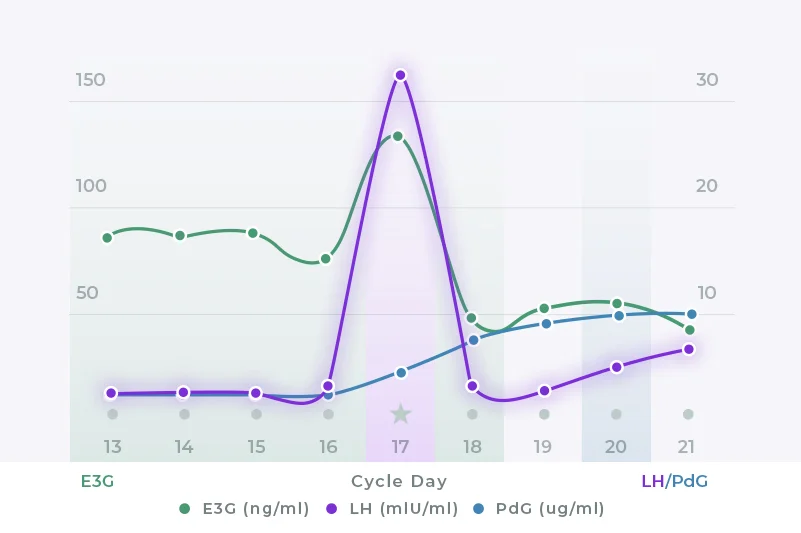
Biphasic surges
This is when one LH spike is followed by a second one. About 33% of cycles have biphasic surges.
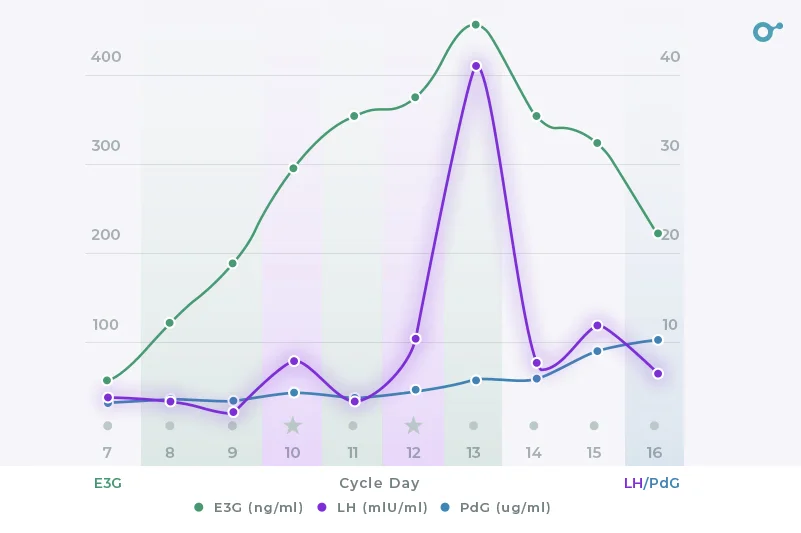
Plateau patterns
This is when LH rises and remains high for several days before eventually dropping. Around 11% of cycles follow plateau patterns.
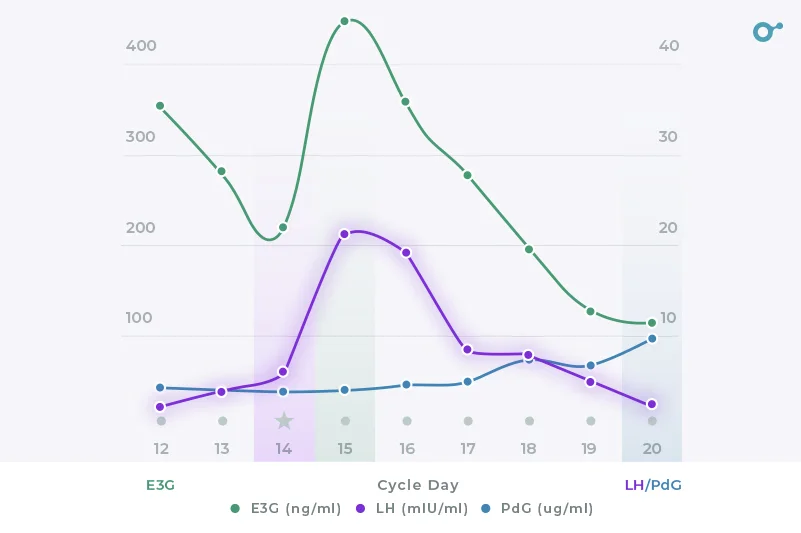
Multiple surges
While rare, this pattern is when more than two LH spikes occur. About 8% of cycles have multiple surges.
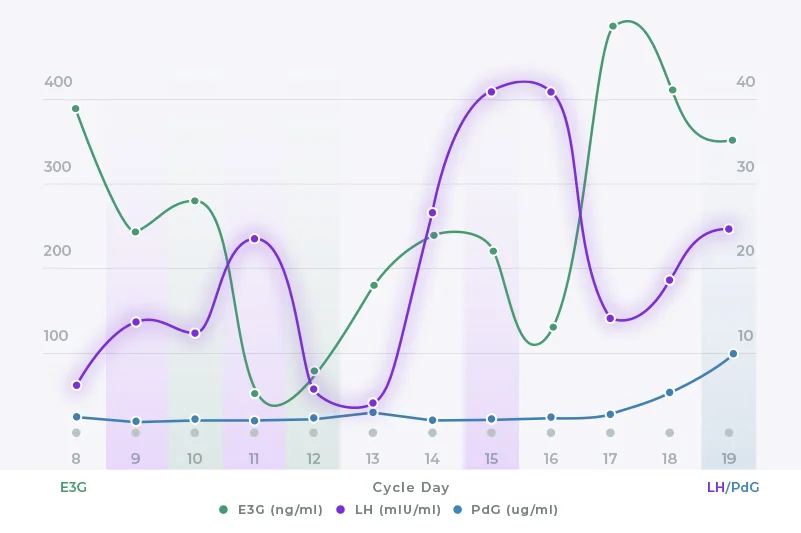
Do LH Patterns Look the Same Each Month?
Some studies suggest that patterns are consistent within an individual from cycle to cycle. This suggests that if you have two LH spikes one month, you’ll have two the next.
Yet other research contradicts this and shows that LH surges can be extremely variable. So don’t expect your monthly surges always to be look-alikes.
It’s important to note that the progesterone rise after the LH surge is the one that confirms ovulation.
Keeping that in mind, here are some guidelines to go by:
- If you tend towards one spike and your LH is high, ovulation is likely on its way.
- If you’re part of the two-surge club, a higher LH could mean it’s your second LH surge.
- If you’re prone to plateau patterns, you could still get a high LH reading several days after an initial surge.
Regularly testing your LH helps you gauge when your surge begins, so you know when you’re most fertile.
How Long Does an LH Surge Last?
As mentioned, an LH surge typically lasts around two days or roughly 24-36 hours.
Yet, that’s not always the case.
Like LH patterns, the onset of surges varies and can be broken down into two groups:
Rapid or short onset – which happens within one day
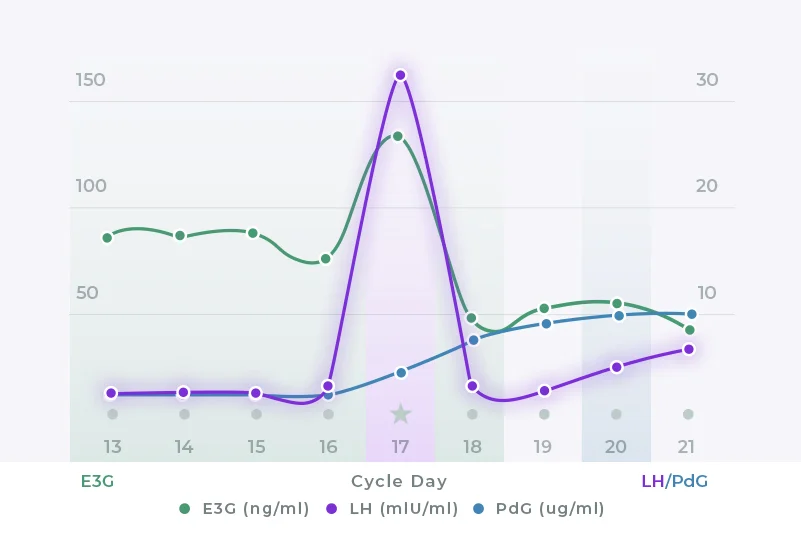
Gradual onset – which occurs over 2-6 days
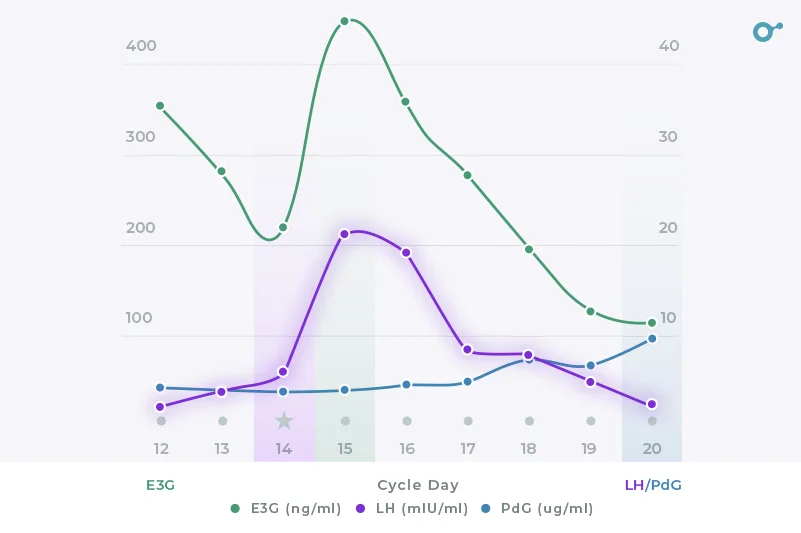
How Much Does LH Increase During a Surge?
One study showed the average LH surge increased 7.7-fold from baseline levels.
For example, if your LH level was 10 at the beginning of your cycle, it would rise to 77 during your surge.
But keep in mind, that’s just the average. Like LH levels, surge increases are not a one-size-fits-all.
The same study showed LH surges can range from anywhere between a 2.5–14.8 fold increase.
So, what would this look like?
Say two people have a baseline LH of 8.0 mIU/mL at the start of their menstrual cycle.
- One person’s LH surge may only reach 20 the day before ovulation.
- The other person’s LH peak could be as high as 118!
And both may still ovulate! This is where most ovulation tests fail to give you accurate results.
Many OPKs rely on average thresholds. If you meet that threshold, you get a positive result.
The problem with threshold-based tests is that they don’t account for people whose LH levels are outside the norm.
For example, if your LH surge is lower than the threshold, you could get a false-negative. And if your LH surge is higher than the threshold, you may get a positive result – even if ovulation never occurs.
Apart from thresholds, the type of LH being tested can also throw off your results.
Alpha LH vs. Beta LH: What’s the Difference?
LH comes in two different subunits: Beta LH and Alpha LH. Knowing the difference between the two is crucial because it can affect your results.
LH and Follicle-Stimulating Hormone (FSH) are hormones your pituitary gland secretes. They’re made up of similar genes and have similar qualities – each with an alpha and beta subunit.
Here’s the confusing part: The alpha subunit of LH and FSH are identical. So if you’re using a test that measures alpha LH, it may cross-react with FSH.
You may intend to check your LH, but the test may pick up on FSH and give you the wrong result.
Now for the good news: The beta units of LH and FSH are different, giving each hormone its unique properties.
That’s why Inito tests beta LH and NOT alpha LH. Using beta units means better accuracy, clear peaks, and less chance for cross reactivity.
What Are My Options for Testing My LH Levels?
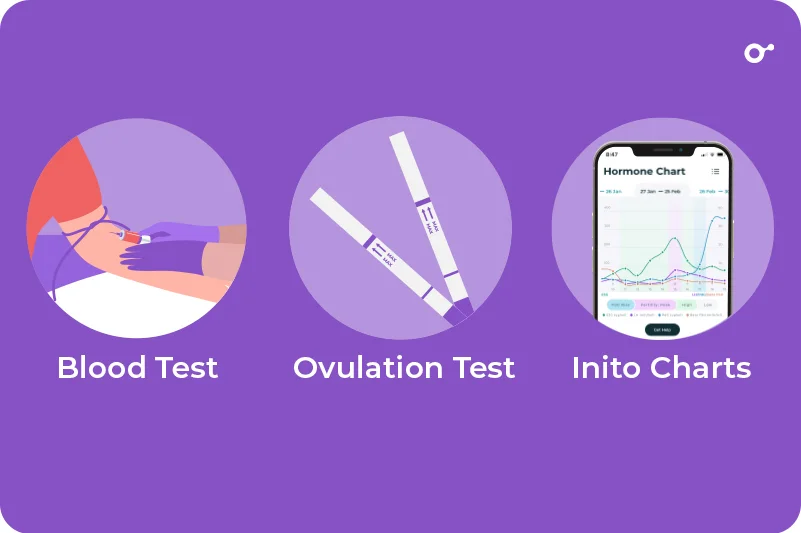
Regular LH testing is one of the most powerful tools for tracking your fertility. If you want to check your LH, you have a few options:
Take an LH blood test
One way is to get an LH blood test at your doctor’s office. The upside of this is that blood tests offer the most accurate results. But there are a few downsides.
To begin with, visiting a lab every month is inconvenient. And people trying to conceive may take up to 10-15 LH tests each month! This can make you start to feel like a pin cushion.
Plus, blood tests often take a day or two to be processed and analyzed. So, by the time you get your results, your fertile window may have passed.
Use an ovulation test
Ovulation Predictor Kits (OPKs) measure the LH in your urine to pinpoint when the surge occurs. And since they’re done at home, they’re far more convenient than blood tests.
But when it comes to ovulation kits, it pays to be choosy. As explained above, many ovulation tests base their results on thresholds, rather than actual hormone values. This may work if your hormone values are average, but not if they fall outside the norm.
Use a fertility monitor
Using a fertility monitor is an accurate and convenient way to measure your LH.
The Inito monitor allows you to see your hormone levels for FSH, LH, estrogen, and PdG (urine metabolite of progesterone) all from one simple test.
You can also access a handy app with personalized hormone charts to share with your doctor. You can even set auto-reminders when it’s time to test, so you never miss your fertile window.
When's the Best Time to Test LH?
It depends on your menstrual cycle.
Most ovulation tests recommend you start testing a few days before your expected ovulation day. And ovulation usually happens between 12-14 days before your next period.
So, if you’re on a 30-day cycle, you could expect to ovulate around day 14-16. But you’d want to start testing your LH several days before that to make sure you don’t miss the surge.
Inito guides you to start testing from day 6 of your cycle to ensure accurate tracking of your fertile window. Starting on day 6 helps measure the rise in your estrogen levels and your LH surge so that you have a clearer picture of your fertile days.
The time of day you test is important too. Your hormones are most concentrated in your morning urine, so it’s usually the best time to test.
If you drink a lot of fluids and test later in the day, your urine may be too diluted to offer accurate results.
Learn More: When is the Best Time to Take an Ovulation Test?
What if My LH Is Too High?
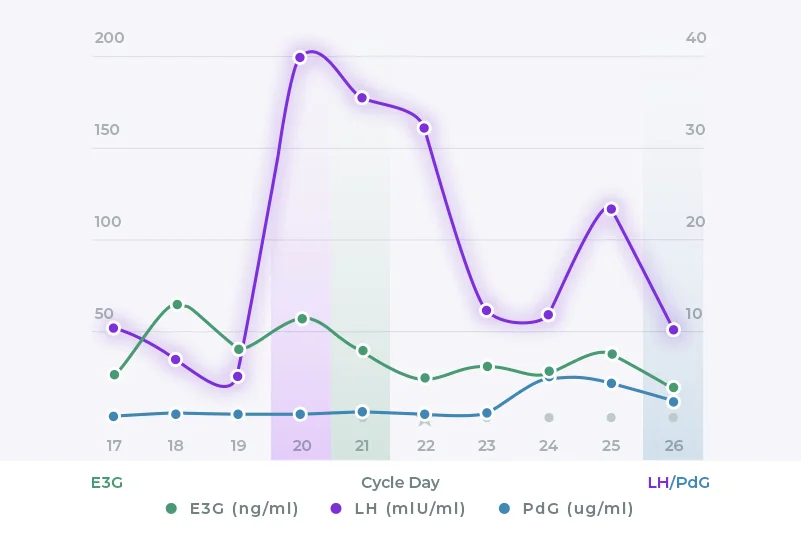
If you take an LH test and fall above the normal range, there are a few possibilities:
- You could have polycystic ovary syndrome (PCOS), a common hormonal condition that affects many women in their reproductive years.
- Your ovaries may be struggling with ovulation.
- You may have Turner syndrome, a genetic disorder that affects fertility.
If your LH levels are higher than the norm, talk with your doctor. They can perform the proper testing to determine what’s causing the imbalance and suggest appropriate treatment options.
What if My LH Is Too Low?
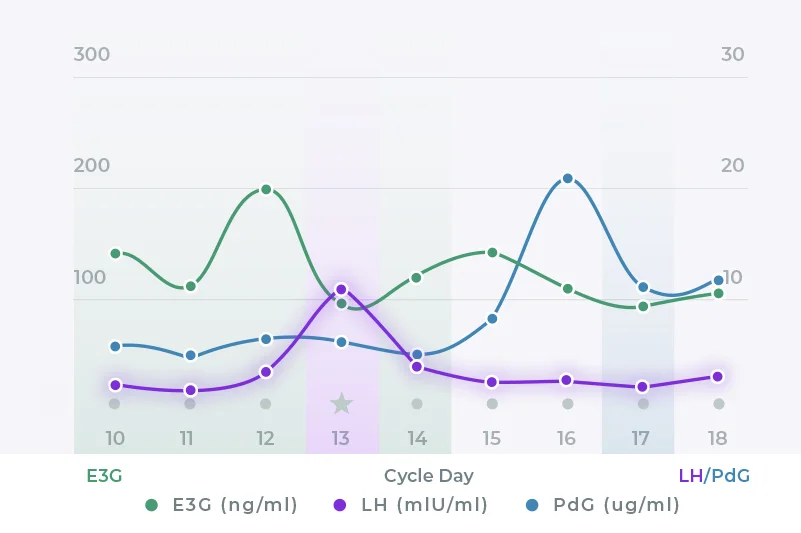
If your LH is lagging, there are a few possible culprits. It may be due to a problem with your pituitary gland.
You could also have Kallman syndrome, a genetic disorder that decreases gonadotropin-releasing hormone (GnRH). When GnRH is low, it affects the production of other sex hormones, including LH.
Stress, extreme weight loss, and strenuous exercise can also throw your hormones out of whack and hinder LH production.
If this is the case for you, practicing healthy lifestyle habits may help boost your body’s natural production of LH. Managing stress, eating a nutritious diet, and practicing healthy sleep habits are good places to start.
That being said, if your levels of LH are low, the best thing you can do is speak with your doctor.

FAQs
There’s no set amount of LH that can ensure you will conceive. What’s important is that your LH surged high enough to trigger ovulation for you. That said, one study found that the average LH surge is around 44.6 mIU/mL,+ but that LH levels could be as low as 6.5 or as high as 101 and still lead to successful ovulation.
For women, LH levels fluctuate throughout their menstrual cycle. So what’s considered “normal” depends on where in your cycle you’re at and what your baseline levels are. But in general, LH levels should be lower during your follicular phase and luteal phase, and rise just before ovulation. Here’s how LH blood ranges might look at various points in your cycle:
- Follicular phase: 1.68 to 15 IU/mL
- Midcycle peak: 21.9 to 56.6 IU/mL
- Luteal phase: 0.61 to 16.3 IU/mL
The exact LH level will vary from woman to woman, but PCOS patients usually have LH levels that are higher than normal. In fact, one study found that nearly 3 in 4 women with PCOS have LH levels that go beyond the 95th percentile.
Here’s a breakdown of the ranges of LH urine levels for women at different parts of the menstrual cycle:
- Follicular phase: 1.68 to 15 IU/mL
- Midcycle peak: 21.9 to 56.6 IU/mL
- Luteal phase: 0.61 to 16.3 IU/mL
- Pregnancy: Below 1.5 mIU/mL
Was this article helpful?
- Physiology, Ovulation And Basal Body Temperature – StatPearls – NCBI Bookshelf
- Overview: Luteinizing Hormone (LH), Serum
- Luteinizing hormone and its dilemma in ovulation induction – PMC
- Ovulation Prevalence in Women with Spontaneous Normal-Length Menstrual Cycles – A Population-Based Cohort from HUNT3, Norway – PMC
- Relationships between the luteinizing hormone surge and other characteristics of the menstrual cycle in normally ovulating women – Fertility and Sterility
- Luteinizing hormone surge in normally ovulating women – Fertility and Sterility
- Characteristics of the urinary luteinizing hormone surge in young ovulatory women – Fertility and Sterility




